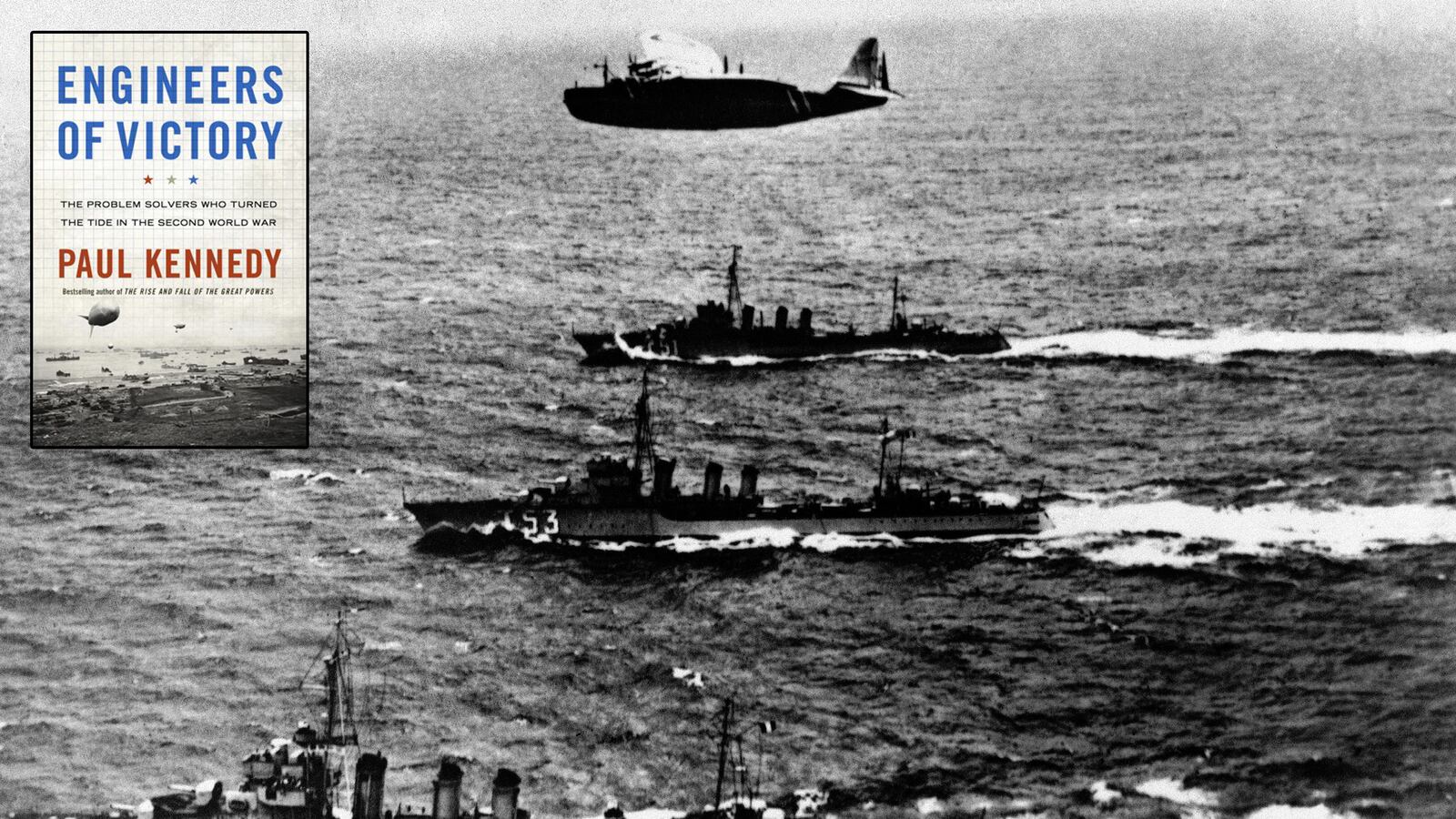“A sniper shooting at you is not science,” a scientist acquaintance who fought for Israel in several wars once said to me. He was, however, a mine remover, à la The Hurt Locker. “A mine is a task. It plays into the scientific mind.”
Amid the violence, chaos, and terror of war, some people must apply their rational minds to sorting and solving dangerous stumbling blocks like mines. On a larger scale, smart, inventive and diligent engineers behind the lines must draw on data from the battlefield to come up with solutions to myriad problems, many of them completely novel.
In Engineers of Victory: The Problem Solvers Who Turned the Tide in the Second World War, historian, international security authority, and Yale professor Paul Kennedy turns on their heads many standard notions about how the Allies won. He lays out what he deems the five great battlefield challenges the Allies faced in 1943 and early 1944. These were the U-boats lurking along the shipping routes through the North Atlantic, the Nazi fighters waiting for the Allied heavy bombers flying over Europe, the blitzkrieg tactics that had overwhelmed Western Europe and threatened the Soviet Union, the fortified shores of Europe that stood in the way of amphibious invasions, and the ocean separating the American forces’ home base from Japan. He then explains how the behind-the-scenes engineers solved those problems through experiment, ingenuity, and resourcefulness.
Historians have long argued over what wins wars. Economic power to build overwhelming military might is the standard deterministic answer. Exiled French resistance leader Charles de Gaulle said immediately after the Japanese attack on Pearl Harbor and U.S. entry into the World War, “Well then, this war is over. Of course, there are more operations, battles and struggles ahead; but ... the outcome is no longer in doubt. In this industrial war, nothing can resist the power of American industry.” Tell that to the veterans who came back from Vietnam or to the seemingly unbeatable German Army that massed the greatest land force in human history on the Eastern Front, expecting to welcome Hitler into the Kremlin within six weeks.
Victory, though, obscures just how complicated winning a war is. Nothing remotely like the Allied strategic program in World War II, on such a scale against such powerful foes, had ever been undertaken before in human history. And at the beginning of 1943, things did not look very promising at all for the Allies.
Beyond the danger of imminent Soviet collapse, German U-boats were sinking Allied ships at a horrifying rate—more than 1,600 ships, 7.8 million tons worth of them, in the past year alone. How would the Allies ever retake Europe if they could not even get food, fuel, and weapons to Great Britain?
Things were worse overhead. The air-force planners who insisted heavy bombers would prove unstoppable attacking targets deep within German territory and would alone be enough to shatter the enemy’s will to fight proved horribly wrong as Nazi fighters swatted down the Flying Fortresses and Liberators like flies. In one horrifying instance, 60 of 291 U.S. Army Air Force B-17s were shot down and a further 138 damaged in a single October 1943 raid. Air losses were so appalling that the Anglo-American air arms stopped sending long-range bombers over Europe altogether for a period.
Few believed that an amphibious assault on France’s coast—an invasion on a scale unlike any prior sea attack in world history—would even reach the beaches. And only some lucky breaks had so far allowed U.S. Navy forces to slow the Japanese drive into the South Pacific.
But in less than 18 months, by June 1944, the Allies had figured out how to storm the beaches of Normandy; the Russians turned aside the Nazi lightning military tactics that had overwhelmed every previous enemy; Americans had taken one Pacific island after another 6,000 miles from home. How did the Allies turn the tide?
There was no one or two great breakthroughs, Kennedy contends. In fact, the solutions were a combination of small advances, many of them interrelated, each in its way indispensable in overcoming the Axis powers’ might.
Kennedy dwells lovingly on the eccentric scientists, naval officers, and others who outfitted the British Admiralty unit called the Department of Miscellaneous Weapons Development, locally known as Wheezers and Dodgers. Men brought up on H.G. Wells and Jules Verne science fiction set their minds to solving the convoy crisis. They studied where the U-boats preyed on ships and convinced the air services to add an extra fuel tank to extend aircraft coverage enough to close the North Atlantic gap. They came up with the U-boat-killer shipboard multiple-grenade launcher called the Hedgehog, for its spiked look, as a supplement to less effective depth charges and tinkered with other weaponry to reach the deep-diving subs. Add to that the development of cavity magnetrons: escort ships and aircraft began to carry these small microwave radars enabling them to spot and chase down wolfpacks lurking in wait for the convoys, sometimes hundreds of miles away.

British ingenuity was transferred over to American industry, which pumped out vast numbers of escort carriers, destroyers, and long-range seaplanes, outfitted with cavity magnetrons to hunt and weaponry with which to kill. The hunter now became the hunted. After these advances, U-boat crews suffered the worst casualty rates of any major service in any nation’s army. And the convoys reached their ports.
Advances chained one to another: Getting the bombers through required the extension of fighter-aircraft flying range. Americans built a fighter, the P-51, with aerodynamics that seemed to defy the laws of physics. A British test pilot took it up. Struck by its prowess, he happened to know of a high-powered Rolls-Royce engine, the Merlin, that would surely extend the P-51’s performance and range. Suddenly the Merlin-powered Mustang, as it was called, required far less fuel than any other fighter and outperformed them all. Supplement those Mustangs with fuel drop tanks, and they could protect the heavy bombers all the way to their targets deep in Germany and back. American assembly lines turned out thousands of Mustangs with Merlin engines, and recognizing the odds, Luftwaffe pilots who previously rose up to meet the bombers now stayed on the ground.
So effective were these weapons, arrived at by trial and error, serendipity, and deep study of battlefield data, that when D-Day arrived, the Allies had total control of sea and air. Ships crossed the Channel and aircraft patrolled overhead, millions of troops landed, and the Germans could muster little in answer. Those lessons that enabled successful convoying, long-range bombing, and beach landings were transferred to the Pacific, where the Navy added fast aircraft carriers, Marines stormed the coral islands, and, together with the B-29, they conquered the “tyranny of distance” and Japan.
On the Eastern Front, the Red Army in its titanic struggle with the Nazis, too, through harsh experience, engineered answers to the battle-hardened foe’s superior tactics and powerful, swift tanks. The Soviets built a great tank of their own, the T-34, but the behemoth was rarely a match for the more mobile German panzers in the epic tank battles on the steppes. Soviet forces slowed Nazi advances, however, by laying vast and treacherous minefields. Engineers behind the lines developed effective antitank guns, and artillery leaders learned to concentrate fire. The Nazis could not respond from the air, as their fighters were largely called back to protect the homeland, now under massive aerial bombardment. Thanks to the American and British bombers now getting through to pound German oilfields and refineries, the Nazis ran desperately short of fuel to drive the tanks and trucks.
The seemingly unstoppable Nazi speed, shock, and mobility tactics soon stalled; Russian snow, ice, and mud did their parts. The Red Army’s overwhelming numbers could now come into play as Soviet troop hordes encircled, cut off, and killed the invading German armies. Again the hunter became the hunted. With convoys now able to cross the Atlantic largely unopposed, thousands of American-built trucks, other vehicles, and aircraft reached the Red Army and enabled them to torture the retreating Germans all the way back to Berlin.
Again and again, Kennedy “reverse-engineers” the five major problems to show how multiple organizational, tactical, and technological solutions, one fitting with another and one ally’s strengths complementing another’s, enabled victory at sea, victory in the air, and victory on the land.
The engineers moved back and forth between the war front and their labs, factories, and offices. They systematically gathered and sifted data, set up organizational-feedback loops, encouraged experimentation, and applied technological and organizational advances to combat that reversed the momentum on every battlefield. And while they sought to overcome these daunting problems, a war was being fought—the snipers were shooting at the mine removers.
Kennedy is best known for his historical analysis of imperial overreach in The Rise and Fall of the Great Powers, which in studying the fate of previous empires, including his birth nation of Great Britain, forecast the impending collapse of the Soviet Union and also proved prescient for poorly planned and costly American imperial forays under President George W. Bush. I have attended a few of his talks, which are blessed with cogency, wit, and deeply researched and clearly presented arguments. The same qualities fill the pages of Engineers of Victory.
In war, incremental problem solving, so marked by trial and error and bureaucratic infighting, may seem dull, somehow less than heroic. It’s not Churchill growling “We shall fight on the beaches,” the Marines raising the Stars and Stripes over Iwo Jima, the Flying Fortresses bucking about amid the hot iron flak storm over Berlin. It’s not shouting back “NUTS!” to the call for surrender at Bastogne. Sure, all that had to occur to win. But in war, as in business, “there has to be a support system, a culture of encouragement, efficient feedback loops, a capacity to learn from setbacks, an ability to get things done,” Kennedy writes.
Any organization will benefit from understanding what sorts of individuals and organizational qualities it took to turn the tide after the Allied leaders met at Casablanca in January 1943 and set their grand strategic program for victory.
At that point, though, the Allies could not possibly have landed on the beaches of Normandy, driven the Germans back through Poland, or campaigned through the Western Pacific with any hope of success. But they accomplished just that.

